Net Radiation Balance
Net radiation (Rn) is the balance of the shortwave and longwave radiation streams, such as:
| ( 1 ) |
Rsw and Rlw are the shortwave and longwave components and the arrows denote the direction of the flux, generally expressed in units of Watts per square meter {Wm-2}. Thus, the Rn is the difference between total upward and downward radiation fluxes and is a measure of the energy available at the ground surface.
The importance of Rn is that it is the fundamental quantity of energy available at the earth's surface to drive the processes of evaporation, air and soil heating, as well as other, smaller energy-consuming processes such as photosynthesis.
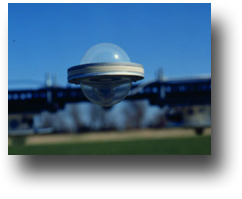
Instruments
REBS Net Radiometer
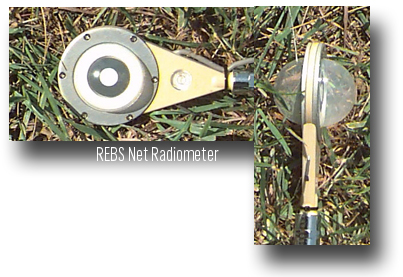 The net radiometer is an instrument used to measure, hemispherically, net all-wave radiation from incoming and outgoing radiation. The receiving surface of a net radiometer is a blackened plate across which there is a thermopile with one set of junctions in contact with the upper face and the other set attached to the lower face. With the plate aligned parallel to the surface the thermopile output is related to the temperature difference across the plate. The difference in temperature is translated into a difference in voltage output of the thermopile and this is proportional to the difference between the total incoming
The net radiometer is an instrument used to measure, hemispherically, net all-wave radiation from incoming and outgoing radiation. The receiving surface of a net radiometer is a blackened plate across which there is a thermopile with one set of junctions in contact with the upper face and the other set attached to the lower face. With the plate aligned parallel to the surface the thermopile output is related to the temperature difference across the plate. The difference in temperature is translated into a difference in voltage output of the thermopile and this is proportional to the difference between the total incoming ![]() and
and ![]() outgoing radiation fluxes at all wavelengths.
outgoing radiation fluxes at all wavelengths.
To overcome the effects of wind differences on the two faces the plate is either forcefully ventilated at a constant rate, and/or protected by a hemispheric dome of polyethylene. This polyethylene material is virtually transparent to radiation with wavelengths in the range of 0.3 to 100µm. The Radiation and Energy Balance Systems (REBS) Model Q*6 net radiometer uses a rigid polyethylene dome which does not absorb a significant amount of radiation. A tube of desiccant is placed inside the boom of the radiometer to absorb humidity inside the dome.
Kipp & Zonen Model CNR1 Net Radiometer
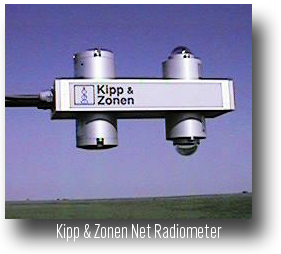 The Model CNR1 measures the four radiation components separately. The two CM3 pyranometers measure shortwave radiant flux from 0.3 to 3.0 µm. The two CG3 pyrgeometers measure Far Infra Red radiant flux from 5 to 50 µm. The gap between these tow instruments produces negligible errors. The instrument is robust, virtually maintaince free and calibration is relatively straightforward. The CG3 pyrgeometer values are correct for temperature errors of the sensor with respect to the surface that it is sensing. Values are reported in Watts per meter squared.
The Model CNR1 measures the four radiation components separately. The two CM3 pyranometers measure shortwave radiant flux from 0.3 to 3.0 µm. The two CG3 pyrgeometers measure Far Infra Red radiant flux from 5 to 50 µm. The gap between these tow instruments produces negligible errors. The instrument is robust, virtually maintaince free and calibration is relatively straightforward. The CG3 pyrgeometer values are correct for temperature errors of the sensor with respect to the surface that it is sensing. Values are reported in Watts per meter squared.
Dew and frost on the dome and window of the sensors will cause errors in measurements. A heater has been built into the sensor to reduce the occurrence of these phenomena. In both the CM3 and CG3, thermal sensors are used. These sensors in principle measure heat flow. For optimal performance, these sensors should be at equilibrium with the ambient air. Heating the sensor disturbs this equilibrium, therefore, heating should only be done if absolutely necessary and if power requirements are not limited. Under most conditions the accuracy that is gained by heating will be larger than the errors that are introduced by heating.
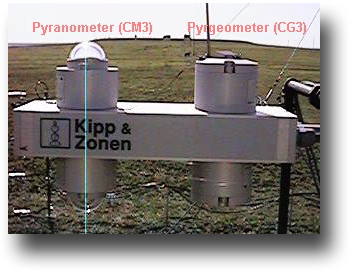 The dome of the CM3 has a good cosine response across all solar incident angles. The window of the CG3 sensor has an ideal response, up to 75 degrees angle of incidence. When calibrating the instrument assumptions are made about the behavior of the sky near the horizon and errors caused by this assumption are small.
The dome of the CM3 has a good cosine response across all solar incident angles. The window of the CG3 sensor has an ideal response, up to 75 degrees angle of incidence. When calibrating the instrument assumptions are made about the behavior of the sky near the horizon and errors caused by this assumption are small.
- Radiation and Energy Balance Systems, Inc.
P.O. Box 15512
Seattle, WA 98115-0512
Phone: (206) 624-7221 - LI-COR, Inc.
Box 4425
Lincoln, NE 68504
(402) 467-3576
Internet: http://www.licor.com/
Calibration
a) Calibration of REBS Net Radiometer
REBS recommends replacing the polyethylene domes with factory supplied domes every 3 to 6 months at which time the net radiometer should be recalibrated. (Replacing the domes alone may result in a 3% change in the calibration factor.) Recalibrating every 3 to 6 months may not always be practical but since most of our applications are for a 3-5 month growing season, a yearly calibration is suggested. Calibration is not a simple task since it involves calibration- source-measures of all radiation streams from which net radiation is calculated and compared. Factory calibration is recommended.
b) Calibration of Kip & Zonen Net Radiometer
Calibration of the instrument by the factory is recommended every two years. This is recommended because of the ability to recalibrate the CG3 pyrgeometers and to replace resistors in the sensors. The CM3 pyranometer can be recalibrated against a known standard pyranometer during clear sky periods.
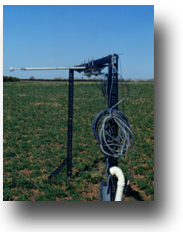 4. Installation
4. Installation
The instrument has to be securely attached to a stand, and it has to be leveled or mounted parallel to the surface of interest. Do not subject the instrument to shocks or vibrations during installation or operation. If there is a chance of electrical interference (e.g., from power lines or radio transmissions) the cable that connects the net radiometer with the data storage device should be shielded.
Net radiometers should be placed on a readily accessible site that is free from any significant obstruction above the plane of the sensing element. If possible, locate the instrument such that
- a shadow will not be cast on it or under it at any time ( i.e., face the instrument to the south);
- it should not be close to light-colored objects that could reflect sunlight on it; and
- it should not be exposed to artificial radiation.
Click Here for Sample Data
Operation and Maintenance
There are four main requirements to ensure the collection of reliable data. They are:
- periodic verification of instrument calibration (at least once a year);
- application of corrections, if necessary, to account for instrument obstruction to a free horizon;
- keeping the domes clean and in the case of the REBS Model Q*6, replacing the windshield when cracks and scratches appear; and
- replace desiccant often.
The REBS Model Q*6 polyethylene domes deteriorate with exposure to solar radiation. Domes should be inspected frequently and replaced if cracks or scratches appear.
The desiccant present in the net radiometer case should be inspected. If the silica gel drying agent is pinkish or white, it should be replaced. N.B. silica gel can be rejuvenated by drying in an oven at 135oC for a few hours until it turns a dark blue color.